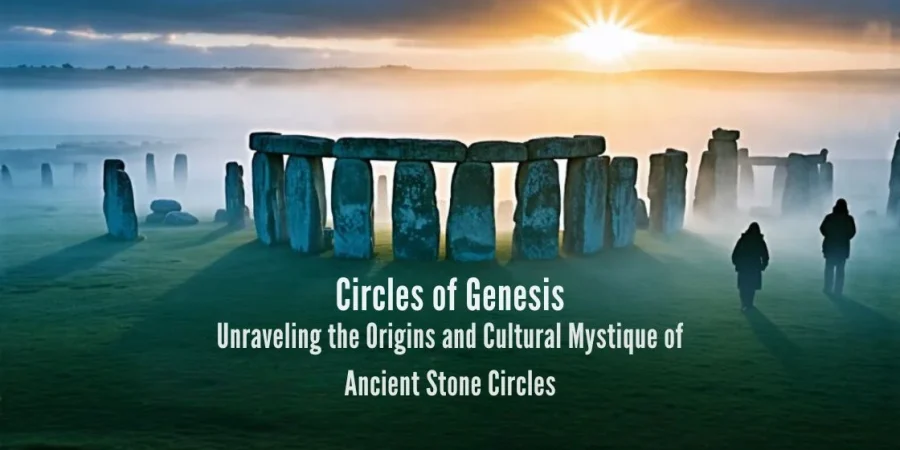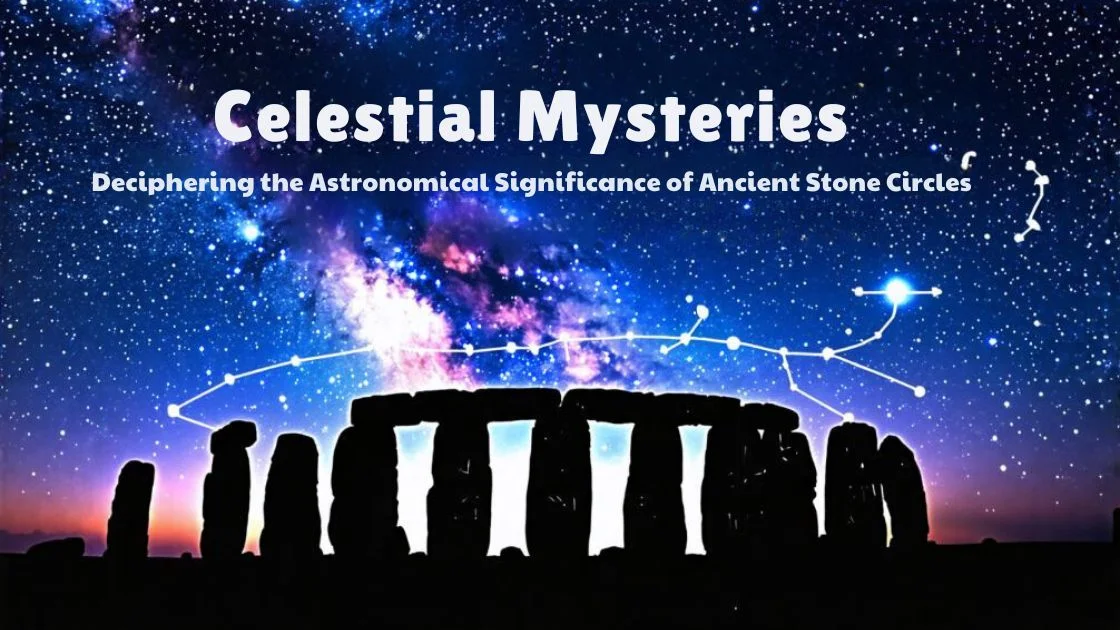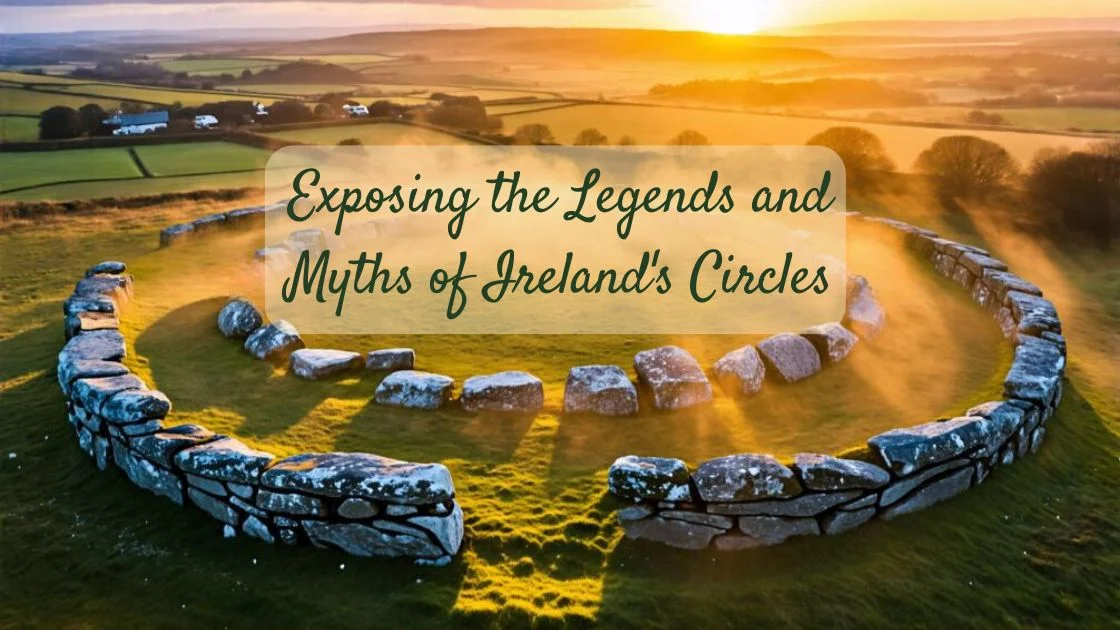You’re on the brink of demystifying the ancient stone circles, those enigmatic guardians of history.
As you dissect their origins and cultural significance, you’ll not only honor the freedom of intellectual inquiry but also cherish the liberty these monuments symbolize.
Embrace this analytical quest to uncover the Neolithic mindset, and let’s preserve the legacy of our ancestors’ monumental endeavors.
Engage with the ‘Circles of Genesis’—a scholarly adventure awaits.
Key Takeaways
- Stone circles are remnants of ancient civilizations in Europe that reflect the ingenuity and symbolism of the Neolithic era.
- Stone circles were not random constructions but had cultural and ceremonial significance, potentially serving as ancient calendars or sacred spaces for ceremonies.
- Stone circles spread across prehistoric societies, with the building techniques and ideas being shared among interconnected communities transcending linguistic and territorial boundaries.
- The composition, design, and placement of stone circles are linked to available geological resources, reflecting technological capabilities, cultural practices, and a connection to the surrounding landscape.
Overview of ancient stone circles as intriguing Neolithic monuments across Europe
You encounter the remnants of ancient civilizations when you observe the stone circles scattered across Europe’s landscapes, monuments of the Neolithic era’s ingenuity and symbolism. These structures are characterized by their varied geometric configurations and sizes, reflecting the diverse cultural practices and social structures of their creators.
In assessing their key features and designs, you’re engaging with the enigmatic legacy of prehistoric societies, interpreting the stones not merely as artifacts but as intricate narratives etched into the earth.
Description of their key features and designs
Why are these ancient stone circles, with their enigmatic formations of towering standing stones, so captivating to your modern imagination? These megalithic structures aren’t only feats of Neolithic engineering but also a testament to the cultural and ceremonial significance they held for their creators.
As you delve into their characteristics, consider the following key features:
- Megalithic Construction: Utilizing massive stones, these structures exhibit an astonishing understanding of quarrying, transportation, and assembly.
- Geometric Precision: The circular or oval layouts, some encompassing concentric rings, showcase a methodical approach to design.
- Astronomical Alignments: Many circles align with celestial events, suggesting advanced knowledge of the cosmos.
These features indicate a society deeply intertwined with the natural world, valuing freedom to explore and express complex ideas through monumental architecture.
The Genesis of Stone Circles
You’ll find that the inception of stone circles during the Late Neolithic period is marked by a variety of theories, each positing a distinct ceremonial or functional purpose.
As you explore how these ideas and construction methods proliferated among prehistoric societies, consider the influence of regional geology on the choice of local materials, which in turn reflects the cultural nuances of those ancient builders.
This analytical approach will guide you in discerning the complex interplay between environmental resources and human ingenuity in shaping these enigmatic structures.
Main theories on origins and inception during Late Neolithic period
Exploring the genesis of ancient stone circles takes you back to the Late Neolithic period, where their mysterious origins were deeply rooted in the spiritual and cultural practices of the time. These enigmatic neolithic monuments weren’t just random constructions; they were a testament to the sophisticated societies that crafted them.
Let’s dissect the main theories:
- Astronomical Observatories: Some suggest these circles were ancient calendars, aligning with solar and lunar events, marking seasons and rituals.
- Ceremonial Sites: Others believe they served as sacred spaces for ceremonies, reflecting the community’s spiritual beliefs and practices.
- Social Gatherings: They may have also been focal points for social interaction, trade, and cultural exchange within and between communities.
Each theory underscores the complexity of the societies that nurtured the origins of stone circles, reflecting a yearning for meaning and connection in the cosmos.
Spread of ideas and building techniques throughout prehistoric societies
As we delve into how these enigmatic stone circles spread their roots across prehistoric societies, it’s clear that their building techniques and underlying ideas were shared among interconnected communities.
This diffusion likely transcended linguistic and territorial boundaries, suggesting a collective ethos valuing the proliferation of spiritual and architectural concepts.
You must consider the varying scales of these monuments, from intimate local settings to grand communal arenas, reflecting a complexity in social structures that sought to harness the cosmos’ perceived order.
The stones themselves, either sculpted by human hands or embraced in their primal forms, bear witness to a prehistoric society’s ingenuity and its drive for perpetuity.
Thus, these circles aren’t merely stones in the landscape but signposts of a shared cultural journey that resonated through millennia.
Local materials reflecting regional geology and cultures
The stones that form these ancient circles echo the diverse geologies and cultures of their respective regions, revealing how each community adapted the shared concept to their local environment. In the realm of landscape archaeology, these ancient structures stand as testimonials to the cultural significance of stone circles, encapsulating the essence of freedom revered by the peoples who built them.
Consider the following:
- Each stone circle’s composition and design are intricately linked to the available geological resources, showcasing regional diversity.
- The chosen materials and construction techniques reflect the technological capabilities and cultural practices of the era.
- The placement of these circles often aligns with the surrounding landscape, indicating a sophisticated understanding of and respect for the natural world.
Your analysis of these stone circles must, therefore, account for the nuanced interplay between environmental resources and cultural expression.
Unraveling Their Meaning and Purpose
As you explore the meaning and purpose of ancient stone circles, consider the precision of their astronomical alignments, which suggest a significant ritual importance tied to solstices and equinoxes.
These prehistoric structures may have served as ceremonial gathering sites or territorial markers, integral to the social fabric of the communities.
Additionally, their design and orientation likely mirror the cosmological beliefs and ancestral veneration practices, possibly even functioning as ancient calendars.
Astronomical alignments suggest ritual importance of solstices, equinoxes
You’ll uncover that numerous stone circles align precisely with the movements of the sun, highlighting their creators’ sophisticated understanding of celestial events. This alignment suggests that Neolithic cosmology was intricately tied to the rhythms of nature, serving both as calendars and timekeeping devices. The ritual importance placed on solstices and equinoxes was likely significant, as these celestial events would have marked critical transitions in the seasonal cycles that governed everyday life.
- Solstice Alignments: Many circles have sightlines that frame the rising or setting sun on solstices, marking the longest and shortest days.
- Equinox Symmetry: Some stones are positioned to catch the sun at equinox, when day and night are of equal length.
- Lunar Observations: Certain sites also align with lunar standstills, indicating a broader celestial tracking system.
This analytical examination unravels the purpose woven into the very fabric of stone circles, reflecting a yearning for understanding and mastery over the binding forces of time and season.
May have marked ceremonial gathering sites, territorial boundaries
Delve deeper into the enigma of stone circles, and you’ll find they may also have served as epicenters for ceremonies and demarcations of ancient territorial boundaries. These megalithic constructs often lie at the nexus of ritualistic practices, standing as silent witnesses to the cultural paradigms of their creators.
The strategic placement and orientation of the stones suggest a methodical approach in their construction, indicative of a complex understanding of territorial markers within the Neolithic community. The circles’ expansive reach implies an intention to congregate sizable assemblies, possibly for rites or communal decisions.
Yet, despite systematic analysis, the stones keep a tight guard on the full extent of their purpose, challenging scholars to piece together the fragmented mosaic of our ancestral heritage.
Reflected cosmologies, ancestral veneration, calendars
Within these ancient stone circles, you’re witnessing more than mere markers of territory; they’re mirrors of celestial knowledge, venerating ancestors, and sophisticated time-keeping systems.
Your analysis of their purpose reveals a connection to the cosmos, an alignment with the heavens that reflects the ancients’ understanding of their place in the universe.
The symbolism of circles suggests an eternal cycle, a representation of the earth, sun, and moon’s perpetual dance. As you delve into their meaning:
- They embody astronomical precision, marking solstices and equinoxes.
- Ancestral veneration is etched into their very layout, serving as communal focal points.
- Their construction may have functioned as calendars, coordinating agricultural and ceremonial events.
Your exploration affirms that these weren’t isolated monuments but integral to a culture that sought harmony with the natural world.
Parallels to Other Ancient Cultures
You observe that stone circles aren’t an isolated phenomenon, as comparable monuments arise in disparate ancient societies, such as the megalithic constructions of Ancient Egypt and the enigmatic edifices of Göbekli Tepe.
The universality of the circle in these contexts suggests a shared symbolic language, emphasizing unity, connection, and the cycles of nature.
This cross-cultural comparison invites you to consider the stone circles within a broader framework of indigenous cultural expressions and cosmologies.
Compare to monuments of Ancient Egypt, Göbekli Tepe, indigenous cultures
Ancient stone circles in Britain and Ireland share a mysterious kinship with the great pyramids of Ancient Egypt, the enigmatic pillars of Göbekli Tepe, and the sacred structures of indigenous cultures around the world. These monuments, though separated by thousands of miles and years, all embody a profound connection to their creators’ understanding of the cosmos and the afterlife.
- Astronomical Alignment: Just as the pyramids align with celestial bodies, some stone circles are precisely oriented to mark astronomical events.
- Religious Significance: Göbekli Tepe’s pillars and the pyramids are thought to serve spiritual purposes, much like the ritualistic functions inferred for stone circles.
- Construction Feats: Despite technological limitations, all these structures showcase remarkable engineering skills and labor commitment, mirroring a shared human endeavor to achieve monumental greatness.
Universality of circles as symbols of unity, connection, cycles
Humanity’s fascination with circles transcends geography and epochs, as you’ll find these shapes central to ancient cultures far and wide, symbolizing unity, connection, and the eternal cycles of life. The circle’s seamless boundary epitomizes the inclusiveness and continuity that many societies strive to emulate, thus becoming a powerful emblem within their cultural heritage.
These ancient stone circles, you’ll note, are profound symbols of unity and connection, not just within a community, but with the cosmos itself.
As you delve deeper, you’ll discover that these structures were meticulously aligned with celestial bodies, underscoring the universal human yearning to comprehend the universe. Such methodical placement signifies a desire for harmony with natural cycles, reflecting an intrinsic understanding of life’s perpetuity and the interconnectedness of all existence.
Enduring Mystique and Significance
You’ll find that the enigma of ancient stone circles extends far beyond their construction, permeating art and folklore for millennia.
Recognized as heritage sites, they attract a myriad of tourists, offering an invaluable glimpse into prehistoric life and beliefs.
Additionally, contemporary New Age movements have adopted these spaces for modern ceremonies, reaffirming their significance in current cultural practices.
Inspiration for art, literature, folklore through the ages
As you delve into the enigmatic lore surrounding stone circles, you’ll find they’ve long captivated the imaginations of artists, writers, and storytellers. These ancient sacred sites serve as profound inspiration for art and literature, symbolizing the unbounded human quest for meaning and connection to the cosmos. Their enduring mystique translates into a myriad of cultural expressions:
- Visual Arts: Paintings and sculptures that evoke the primal energy and spiritual significance of these prehistoric landmarks.
- Literary Works: Novels and poems infused with themes of ancient wisdom, eternal cycles, and the intertwining of the mystical and the mundane.
- Folklore: Tales and legends that weave the stones into narratives of creation, power, and transcendence.
Your appreciation for these circles might grow as you consider their impact on the creative domain, reflecting an age-old allure that resists the confines of time.
Role as heritage sites and tourist attractions
Beyond their ancient origins, stone circles have evolved into celebrated heritage sites, drawing visitors worldwide with their timeless allure.
Stonehenge in England epitomizes this transformation into tourist attractions, symbolizing the enduring mystique of these prehistoric monuments. Their precise alignments and monumental scale continue to captivate, encouraging both academic inquiry and cultural tourism.
As you explore these sites, you’re engaging with a tangible legacy, a portal to the ritualistic past that maintains relevance in contemporary society. Methodical conservation efforts ensure their survival, allowing you to witness these megalithic wonders and ponder the same celestial mysteries that once obsessed our ancestors.
The circles’ enigmatic origins, coupled with their monumental presence, forge a perpetual bond between past and present, nurturing an unbroken thread of human curiosity and reverence.
New Age embrace of stone circles for ceremonies
While you explore the ancient landscapes, it’s likely you’ll encounter New Age groups who’ve adopted these stone circles as sacred spaces for modern ceremonies, underscoring their unbroken mystique and significance. These circles, once the domain of ancient peoples, now draw those seeking a connection to the cosmos through New Age spirituality.
The ceremonies conducted within these megalithic arenas aren’t mere reenactments but profound expressions of continuity and reverence for the Earth’s primordial wisdom. Key aspects of this New Age embrace include:
- Ritualistic gatherings to align with celestial events
- Energetic healing sessions that tap into the site’s perceived power
- Meditative practices aimed at personal and universal harmony
This analytical approach reveals a sophisticated appropriation of prehistoric monuments, reflecting a deep yearning for spiritual freedom and a timeless link to our ancestors.
Ongoing Study and Preservation
You must consider that recent archaeological efforts are continually providing fresh perspectives on the chronology and functions of these prehistoric stone circles.
However, you’re also faced with the grim reality that these ancient monuments are succumbing to the ravages of time and human activity, underscoring an urgent need for preservation strategies.
A methodical approach to studying and safeguarding these sites ensures that they can continue to offer insights into past societies and maintain their cultural significance.
Recent archaeology and dating continues to uncover new insights
As archaeologists delve deeper into the enigmatic past of ancient stone circles, they’re uncovering revelations that not only refine our understanding of these prehistoric sites but also highlight the urgency of preserving them for future generations.
Your quest for knowledge is supported by sophisticated analytical techniques that have brought new perspectives to these archaeological mysteries:
- Radiocarbon dating is recalibrating timelines, revealing some circles to be older or younger than previously thought.
- Ground-penetrating radar allows for non-invasive exploration, exposing hidden features without disturbing the site.
- Environmental analysis is offering insights into the landscapes these monuments once stood in, informing conservation strategies.
Through recent archaeology and dating, you’re piecing together a puzzle centuries in the making, advocating not just for knowledge, but for the liberty to preserve history’s silent sentinels.
Concerns over degradation and need to protect these monuments
Although recent archaeological techniques have shed light on the age and structure of ancient stone circles, they’ve also highlighted the urgent need for their preservation due to increasing degradation. You must recognize the importance of ongoing study and the need to protect these monuments, which are imperiled by both natural and human-induced factors. Methodical analyses suggest that without intervention, the legacy of these prehistoric marvels could be irreparably lost.
| Degradation Factor | Preservation Action |
|---|---|
| Erosion | Controlled Access |
| Pollution | Regular Monitoring |
| Agriculture | Legal Protection |
| Urban Development | Public Education |
| Vandalism | Restoration Projects |
Your understanding of the fragility of these sites is crucial for their survival. The ancient stone circles symbolize cultural freedoms that once flourished unbound. Now, it’s your turn to ensure these freedoms endure through protection and respect.
Conclusion: there are still mysteries to unravel about these alluring circles
Despite centuries of research, you’re still faced with enigmas surrounding the ancient stone circles’ true purposes and origins. The prehistoric monuments scattered across Neolithic Europe whisper of a time when indigenous cultures worldwide erected these enigmatic structures for reasons that elude full understanding.
As you delve into the mysteries, consider:
- The alignment of some circles with astronomical events suggests a complex understanding of celestial patterns.
- Variations in circle size and stone composition across different regions point to a diversity of cultural practices.
- The erosion and degradation of sites impede efforts to uncover the nuanced rituals that may have taken place within these circles.
Your quest for knowledge is a testament to human curiosity, relentless in the pursuit to unlock the secrets of freedom-loving societies long past.
Conclusion
You’ve journeyed through the enigmatic landscapes of ancient stone circles, pondering their origins and purposes. Despite advancements in archaeology, their full meanings elude us, shrouded in the mists of time.
Yet, you recognize their enduring allure, a testament to our ancestors’ intricate worldviews. As you reflect, understand that preserving these sites is crucial for continuing study.
The stones remain silent, but their secrets beckon, urging us to unravel the mysteries they hold.



